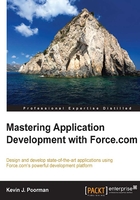
What this book covers
Chapter 1, A Conceptual Overview of Application Development on the Salesforce1 Platform, is a quick refresher of the Force.com development tools and methodologies. We'll discuss the concepts of classes, triggers, and unit testing that we'll be mastering in the further chapters.
Chapter 2, Architecting Sustainable Triggers Using a Trigger Framework, will dive deep into why you would need a trigger, when you should and should not use a trigger, and how to architect triggers for maintainability. Additionally, we'll dig into trigger frameworks that provide cleaner, more scalable solutions that solve many of the problems that plague traditional trigger development.
Chapter 3, Asynchronous Apex for Fun and Profit, is all about Apex classes that implement the batchable, scheduleable, and queueable interfaces as well as the @future method Annotation.
Chapter 4, Lightning Concepts, discusses the four new features of the Salesforce platform that carry the Lightning moniker. We'll start with Lightning connect and move on to cover process builder, app builder, and lightning components.
Chapter 5, Writing Efficient and Useful Unit Tests, talks about unit testing, which is the single most important activity an application developer has to master. However, writing unit tests is rarely seen as exciting. In this chapter, we'll look at how to write useful unit tests that help us maintain our application over time.
Chapter 6, Deploying Your Code, takes you to the next step—you've written and tested your code, now what? This chapter is a tour of the many ways to deploy your application metadata from one org to another. Specifically, we'll cover the Ant migration toolkit, IDE deployment, and Change sets. Additionally, we'll briefly touch on packaging as a means of deploying metadata.
Chapter 7, Using, Extending, and Creating API Integrations, demonstrates how to use the sObject and bulk APIs provided by Salesforce as well as how to create your own custom REST endpoints with Apex. Finally, we'll build out a set of classes to make calling external REST APIs as painless as possible.
Chapter 8, Team Development with the Salesforce1 Platform, discusses and works through the pitfalls of team development in general and the unique solutions available to us on the Salesforce1 Platform.
Chapter 9, My Way—A Prescriptive Discussion of Application Development on Salesforce1, looks at overarching best practices for Architecture and Engineering of applications on the Force.com platform in depth. Specifically, we discuss the nature of keeping things simple, testing things well, naming things intuitively, and writing maintainable code. While the rest of the book has been descriptive of the best practices, this chapter is an opinionated prescription for developing Salesforce1 applications.